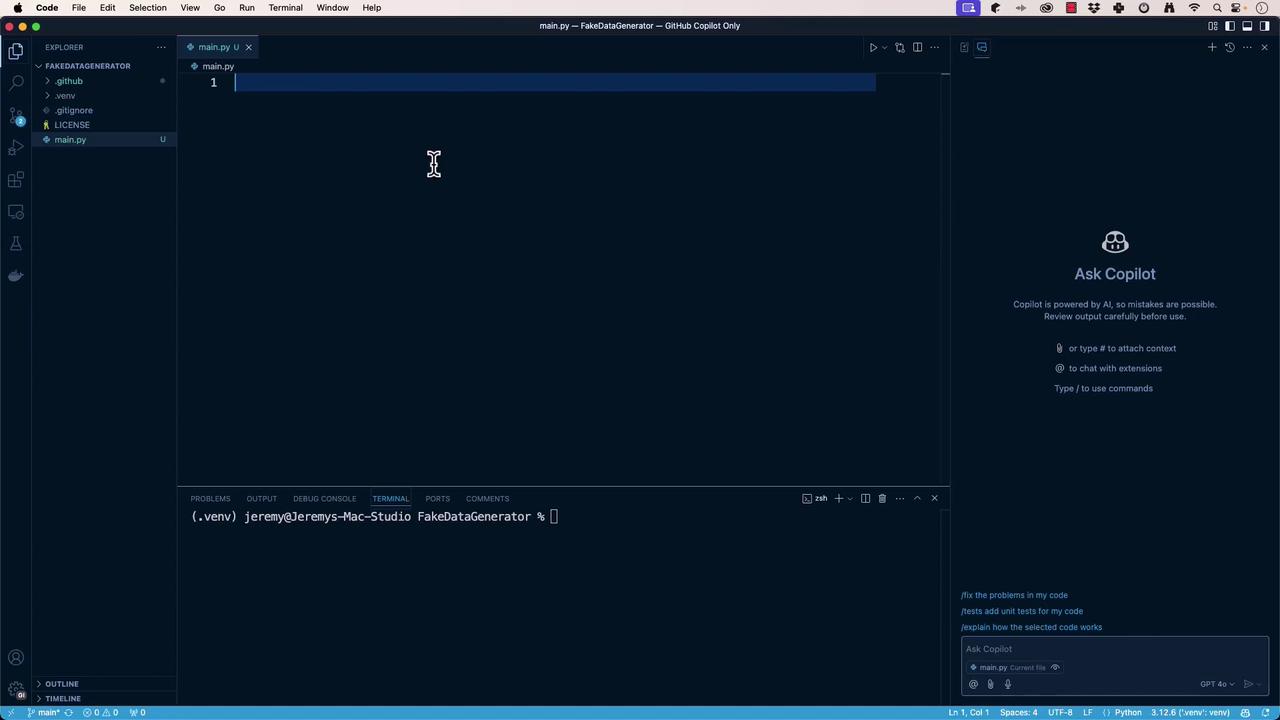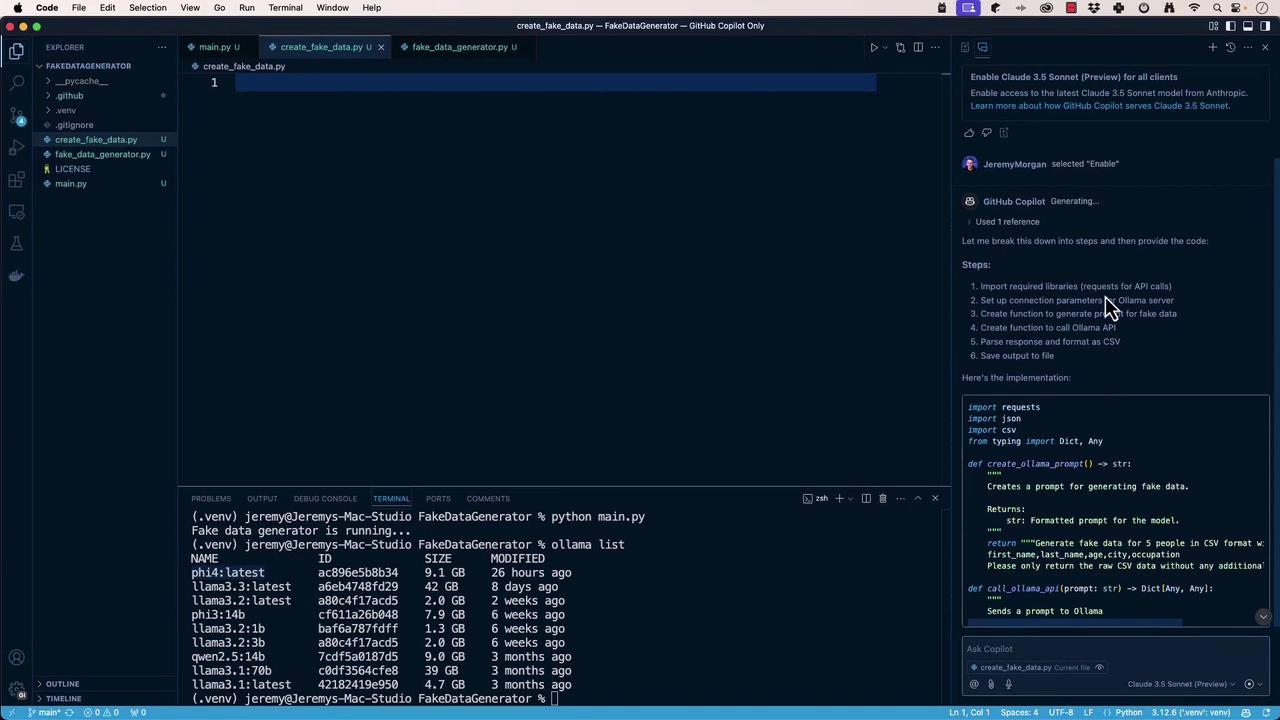GitHub Copilot Certification
Using Copilot Efficiently
Creating a New Project
Kick off your development workflow by leveraging GitHub Copilot, Python virtual environments, and a local Ollama LLM for fake data generation. In this guide, you’ll learn how to:
- Initialize a Git repository
- Configure a Python virtual environment
- Scaffold and modularize code with Copilot
- Generate CSV data via Ollama (local LLM)
- Manage dependencies and
.gitignore
1. Initialize the Git Repository
First, clone or fork your project on GitHub. Your starter repository includes:
LICENSE.gitignore(baseline)- GitHub Copilot instructions
main.py(empty stub)
Open your terminal or VS Code integrated shell:
mkdir my_project
cd my_project
git init
code .
This sets up an empty Git repository and launches VS Code in your project folder.
2. Configure a Python Virtual Environment
Isolating your dependencies prevents conflicts and keeps your project portable. You can follow Copilot’s suggestions or use these commands:
| Step | Command (macOS/Linux) | Command (Windows PowerShell) |
|---|---|---|
| Create project folder & venv | mkdir my_project && cd my_project | mkdir my_project; cd my_project |
| Initialize virtual environment | python3 -m venv .venv | python -m venv .venv |
| Activate environment | source .venv/bin/activate | .venv\Scripts\Activate.ps1 |
| Verify activation | Look for (.venv) in your prompt | Look for (.venv) in your prompt |
Why Virtual Environments?
Virtual environments ensure that pip install only affects your project and avoids version clashes globally. See Python Virtual Environments.
With the environment active, install packages locally:
pip install <package_name>
3. Scaffold main.py with GitHub Copilot
Use the GitHub Copilot extension in VS Code. In Copilot Chat, request:
“Scaffold a
main.pythat defines aFakeDataGeneratorclass and runs it inmain().”
Copilot will generate something like this:
# main.py
import sys
class FakeDataGenerator:
"""
Generates fake data.
"""
def run(self):
print("Fake data generator is running...")
def main():
"""Entrypoint for FakeDataGenerator."""
generator = FakeDataGenerator()
generator.run()
if __name__ == "__main__":
main()
Save and execute:
(.venv) $ python main.py
Fake data generator is running...

4. Refactor Code into Modules
Clean architecture separates concerns. Ask Copilot to extract FakeDataGenerator:
fake_data_generator.py
class FakeDataGenerator:
"""
Generates fake data.
"""
def run(self):
print("Fake data generator is running...")
Update main.py to import the module:
from fake_data_generator import FakeDataGenerator
def main():
generator = FakeDataGenerator()
generator.run()
if __name__ == "__main__":
main()
Re-run to confirm:
(.venv) $ python main.py
Fake data generator is running...
5. Generate Fake Data via Ollama (Local LLM)
We’ll create create_fake_data.py to call a local Ollama API at http://localhost:11434/api/generate, request CSV-formatted rows, and write them to fake_data.csv.
In Copilot Chat, prompt:
“Generate a script that sends a CSV fake-data request to Ollama and saves the response.”
create_fake_data.py
import requests
from typing import Dict, Any
def create_ollama_prompt() -> str:
return (
"Generate fake data for 5 people in CSV format with these columns:\n"
"first_name,last_name,email_address,age,city,occupation\n"
"Only return raw CSV data."
)
def call_ollama_api(prompt: str) -> Dict[Any, Any]:
url = "http://localhost:11434/api/generate"
payload = {"model": "phi4:latest", "prompt": prompt, "stream": False}
try:
resp = requests.post(url, json=payload)
resp.raise_for_status()
return resp.json()
except requests.RequestException as e:
print(f"API error: {e}")
return {}
def main():
prompt = create_ollama_prompt()
result = call_ollama_api(prompt)
if csv_data := result.get("response"):
with open("fake_data.csv", "w", newline="") as f:
f.write(csv_data)
print("Saved fake_data.csv")
else:
print("Failed to generate data")
if __name__ == "__main__":
main()
Install requests and run:
(.venv) $ pip install requests
(.venv) $ python create_fake_data.py
Saved fake_data.csv

Sample fake_data.csv:
first_name,last_name,email_address,age,city,occupation
John,Doe,[email protected],28,New York,Software Engineer
Jane,Smith,[email protected],34,San Francisco,Data Scientist
Emily,Jones,[email protected],27,Boston,Graphic Designer
Michael,Taylor,[email protected],40,Chicago,Lawyer
Sarah,Garcia,[email protected],31,Austin,Marketing Manager
6. Manage Dependencies and .gitignore
Export your locked dependencies:
(.venv) $ pip freeze > requirements.txt
| File | Purpose |
|---|---|
requirements.txt | Lists exact package versions for reproducibility |
.gitignore | Omits local venvs, caches, and editor settings |
.gitignore
# Virtual environments
.venv/
venv/
# Python cache
__pycache__/
*.py[cod]
# VS Code settings
.vscode/
# macOS files
.DS_Store
Stop Tracking Venv
After adding .gitignore, remove any committed virtual environment:
git rm -r --cached .venv
git commit -m "Remove venv from tracking"
Finally, commit your changes:
git add requirements.txt .gitignore
git commit -m "Add dependencies and gitignore"
Next Steps
You’ve successfully:
- Bootstrapped a Python repo with Git and Copilot
- Isolated dependencies in a virtual environment
- Scaffolded, refactored, and modularized code
- Integrated with a local Ollama LLM for data generation
- Locked dependencies and configured
.gitignore
Next, connect your fake data pipeline to a database, add unit tests, or deploy to a cloud service.
References
Watch Video
Watch video content